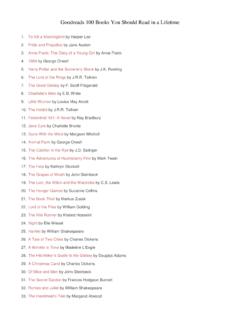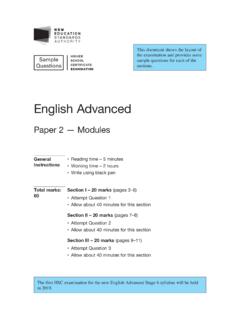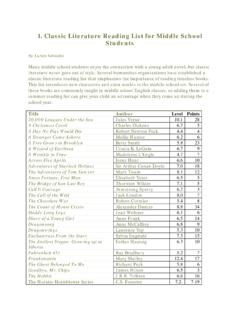Transcription of GCSE (9-1) English Literature - Edexcel
1 GCSE (9-1) English Literature SPECIMEN PAPERS (SET 2)Pearson Edexcel Level 1/Level 2 GCSE (9-1) in English Literature Paper 2 (1ET0/02)Paper 2: 19th-century Novel and Poetry since 1789 Introduction_____ This specimen paper has been produced to complement the sample assessment materials for Pearson Edexcel Level 1/Level 2 GCSE (9-1) in English Literature and is designed to provide extra practice for your students. The specimen papers are part of a suite of support materials offered by Pearson. The specimen papers do not form part of the accredited materials for this qualification.
2 General marking guidance All candidates must receive the same treatment. Examiners must mark the last candidate in exactly the same way as they mark the first. Mark schemes should be applied positively. Candidates must be rewarded for what they have shown they can do rather than penalised for omissions. Examiners should mark according to the mark scheme not according to their perception of where the grade boundaries may lie. All the marks on the mark scheme are designed to be awarded. Examiners should always award full marks if deserved, if the answer matches the mark scheme.
3 Examiners should also be prepared to award zero marks if the candidate s response is not worthy of credit according to the mark scheme. Where some judgement is required, mark schemes will provide the principles by which marks will be awarded and exemplification/indicative content will not be exhaustive. When examiners are in doubt regarding the application of the mark scheme to a candidate s response, a senior examiner must be consulted before a mark is given. Crossed-out work should be marked unless the candidate has replaced it with an alternative response. Candidate s responses need to provide evidence that meets the whole of the level, and preceding levels in a levels-based mark scheme, before being considered against a higher level.
4 Marking guidance specific The marking grids have been designed to assess student work holistically. The grids identify which Assessment Objective is being targeted by each bullet point within the level descriptors. When deciding how to reward an answer, examiners should consult both the indicative content and the associated marking grid(s). When using a levels-based mark scheme, the best fit approach should be used. Examiners should first decide which descriptor most closely matches the answer and place it in that level. The mark awarded within the level will be decided based on the quality of the answer and will be modified according to how securely all bullet points are displayed at that level.
5 In cases of uneven performance, the points above will still apply. Candidates will be placed in the level that best describes their answer according to each of the Assessment Objectives described in the level. Marks will be awarded towards the top or bottom of that level depending on how they have evidenced each of the descriptor bullet points. Examiners of GCSE English Literature should be mindful of the weighting of assessment objectives within the mark grid. The proportion of marks is represented in the indicative content and the levels-based mark scheme. Examiners must consider this when making their judgements.
6 The mark grid heading identifies which Assessment Objective is being targeted by each bullet point within the level descriptors. Indicative content is exactly that it includes factual points that candidates are likely to use to construct their answer. It is possible for an answer to be constructed without mentioning some or all of these points, as long as they provide alternative responses to the indicative content that fulfil the requirements of the question. It is the examiner s responsibility to apply their professional judgment to the candidate s response in determining if the answer fulfils the requirements of the question.
7 For AO3, context is information which informs the understanding of a text. Candidate responses should treat it in ways that are suitable to the text, the author and the specific task. It is important that the contextual information provided is directly relevant, rather than being bolt-on , (general) context that does not illuminate the response to the particular question. Responses to particular questions should select from relevant context to illustrate and develop their interpretation of what is required by the task. The examples in the indicative content section show the link between text, task and context.
8 Points that make these links should be rewarded; general statements which do not support the interpretation should not. Paper ReferencePearson Edexcel Level 1/Level 2 GCSE (9 1)Turn over *S50469A*S50469A 2015 Pearson Education and Extracts BookletSpecimen Papers (Set 2) for first teachingSeptember 2015 Time: 2 hours 15 minutes1ET0/02 English LiteraturePaper 2: 19th-century Novel and Poetry since 17892S50469 ABLANK PAGE3S50469 ATurn over Answer THREE questions:ONE question from Section AONE question from Section B, Part 1 AND Question 11 in Section B, Part extracts and poems for use with Sections A and B are in this A 19th-century Novel Page1 Jane Eyre.
9 Charlotte Bront 42 great expectations : charles dickens 63 Dr Jekyll and Mr Hyde: R L Stevenson 84 A Christmas Carol: charles dickens 105 Pride and Prejudice: Jane Austen 126 Silas Marner: George Eliot 147 Frankenstein: Mary Shelley 16 SECTION B Part 1 Poetry Anthology Page8 Relationships 189 Conflict 2010 Time and Place 22 SECTION B Part 2 Page11 Unseen Poetry 244S50469 ASECTION A 19th-century NovelAnswer ONE question in Section should spend about 55 minutes on this should divide your time equally between parts (a) and (b) of the this extract to answer Question Eyre: Charlotte Bront In Chapter 11 Jane Eyre arrives at Thornfield Hall and is met by Mrs Fairfax.
10 How do you do, my dear? I am afraid you have had a tedious ride; John drives so slowly; you must be cold; come to the fire. Mrs Fairfax, I suppose? said I. Yes, you are right: do sit down. She conducted me to her own chair, and then began to remove my shawl and untie my bonnet strings: I begged she would not give herself so much trouble. Oh, it is no trouble: I dare say your own hands are almost numbed with cold. Leah, make a little hot negus and cut a sandwich or two: here are the keys of the store-room. And she produced from her pocket a most housewifely bunch of keys, and delivered them to the servant.
















